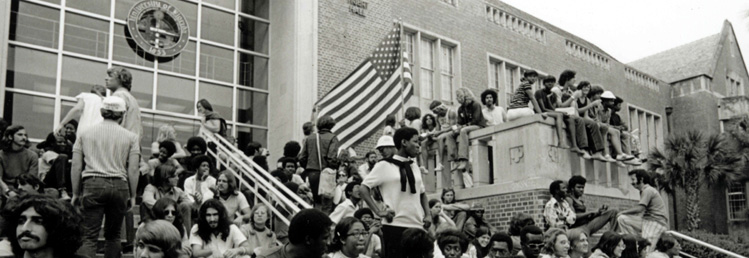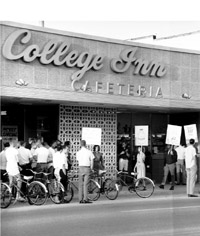

By Bronwyn McCarthy and Candice Ellis
The University of Florida was desegregated in 1958, but by 1971 there were only 343 black students in attendance—a small proportion of the student body in comparison to the 20,000 white students enrolled. The Black Student Union organized a sit-in as an expression of discontent with university policies that did not encourage black student enrollment or the employment of black faculty members. On April 15, 1971, in what would later become known as “Black Thursday,” students gathered in protest outside Tigert Hall and attempted to meet with President Stephen O’Connell. The first delegation of students, which numbered about 50, marched into O’Connell’s office uninvited touting a petition of six demands. They were asked to leave and did so without protest. The next group to storm the office was louder and more insistent, and even after that a third, larger group arrived. President O’Connell refused to meet with them. Angered by this, demonstrators refused to disperse. The protest ended in the arrest of 66 students, 60 of whom were put on academic probation. O’Connell refused to grant the arrested students amnesty because “that would be admitting that the sit-in in my office was proper conduct now and in the future.” Outraged, 123 black students and two black faculty members left the university.
 Student activities in support of Civil Rights had increased signifcantly in the years leading up to the 1971 sit-in. Between the years 1968 and 1970, students organized a Black Student Union. In 1963, students picketed against discrimination at the University College Inn, a popular student eatery. Mainly organized by the UF Student Group for Equal Rights (SGER), the goal of the picket was to encourage Gainesville businesses to desegregate.
Student activities in support of Civil Rights had increased signifcantly in the years leading up to the 1971 sit-in. Between the years 1968 and 1970, students organized a Black Student Union. In 1963, students picketed against discrimination at the University College Inn, a popular student eatery. Mainly organized by the UF Student Group for Equal Rights (SGER), the goal of the picket was to encourage Gainesville businesses to desegregate.